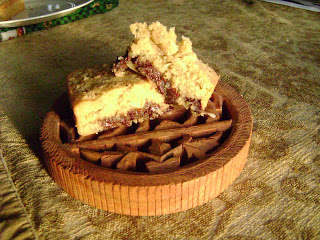I already have a good workhorse recipe for gluten-free brownies in my copy of Elizabeth Barbone's Easy Gluten-Free Baking cookbook. The Betty Crocker GF brownie mix also makes good chewy brownies in a hurry and I use them in this shortcut recipe for a crunchy, cinnamony Mexican Brownie which is really a winner with my crew. So the upshot is, for this Rally I wanted to try a chocolate-less brownie, a blondie.
Then there was this bag of Coconut Powder that caught my eye at the Asian market and has been idling in my baking cupboard for many moons. I have used coconut flour in baking before and enjoy the results, though coconut flour is one thirsty ingredient, requiring a lot of extra liquid in a recipe. I also think it's expensive ($6.49 for a 1 lb. bag at my local health food store). The 2 lb. bag of Coconut Powder cost me $4.99 at the Asian market. The texture is different between the two products: Coconut Flour is silky fine, whereas the Coconut Powder is chunkier and reminds me of panko bread crumbs. I also needed to fish out some bigger chunks of coconut from the Coconut Powder that must have escaped the grinding blades when I was sifting my dry ingredients. Given the price difference between the two products, though, I definitely wanted to play around a bit more with the Coconut Powder.
On the face of it, Coconut Powder seems to be a dessicated, ground up bit of unsweetened coconut meat (and one blogger uses it to make homemade coconut milk) that I thought would add some fiber to my intended blondies. I also wanted to use up the last bit of coconut oil in my pantry and thought that adding in toasted, sweetened flaked coconut would make an awesomely good Triple Coconut Blondie, enhanced with a little bit of chocolate chips.

That was my vision, anyway. When I baked up my first blondie batch, inspired by this toothsome sounding recipe, augmented by even more fiber in the form of ground flax seed and rolled oats, the end result was dry, heavy, and a bit TOO much of a colon cleanser. They were kind of flat too. We ate them, but they were not decadent and moist like a good sweet treat should be.
My second coconut blondie batch left out the oats and flax seed, subbed in a chick pea/tapioca starch/brown rice flour blend and used butter instead of coconut oil and things did improve, but the texture of these coconut blondies still screamed 1970s era health food. Plus all the chocolate chips still kept sinking to the bottom of the blondies instead of pleasantly inserting themselves throughout.
Time to rally back by tinkering with the ratios and ingredients once again.
For my third try, I upped the brown sugar, subbed out chocolate chips for chopped walnuts and added in more toasted flaked coconut. That did the trick; these Double-Co, Double-Nut Blondies were chewy, richly flavored and awesomely good paired with a cold glass of milk.
Co-Co-Nut-Nut Blondies
Vegetable shortening
100 grams coconut powder (feel for lumps of unground coconut and fish them out)
100 grams brown rice flour
25 grams tapioca starch
25 grams chick pea flour (all together you will have about 2 cups flour)
1/4 tsp. baking powder
1/4 tsp. baking soda
1/2 tsp. xanthan gum
1/4 tsp salt
300 grams brown sugar (about 1-1/2 cups)
75 grams butter (about 1/3 cup)
2 eggs, lightly beaten
1/2 tsp. vanilla
1/4 cup water
1 cup sweetened flaked coconut
1 cup chopped walnuts
Grease an 8 x 8 inch baking pan with shortening. Set aside.
Place flaked coconut in an ungreased frying pan. Adjust heat to medium high, and stay right there, stirring continuously, until it toasts to a nice golden brown, about 5-7 minutes. Don't let your coconut burn! Let cool and reserve a couple of tablespoons of the toasted coconut to sprinkle on top of your blondie batter before baking.
Preheat oven to 350 degrees F.
Mix coconut powder, brown rice flour, tapioca starch, chickpea flour, baking soda, baking powder, xanthan gum and salt together until blended.
In a pot on the stove, melt butter. Add in brown sugar and heat, stirring, until it is melted together. Let cool for 5 minutes. Stir in vanilla, eggs and water.
Mix wet ingredients into dry ingredients just until blended. Add nuts and toasted coconut and mix just until blended. Spoon into prepared baking pan, top with reserved toasted coconut and pop in the oven for 30 minutes or until top looks dry and edges have separated from the pan.
Let cool in pan on a rack. When completely cooled, cut into squares.
Makes about 16 blondies.
Be sure to check over at Frannycakes to see all the other inspired brownie and blondie variations made by other GF Ratio Rally bakers.








